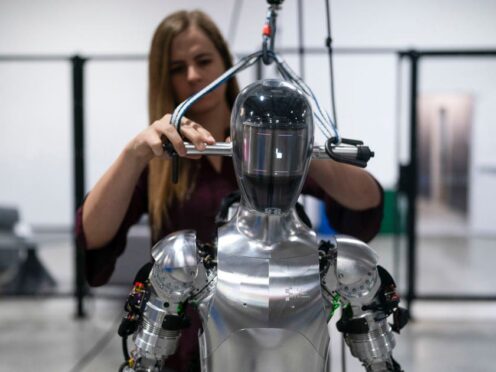
ChatGPT creator OpenAI is looking to fuse its artificial intelligence systems into the bodies of humanoid robots as part of a new deal with robotics start-up Figure.
California-based Figure announced the partnership on Thursday along with 675 million dollars (£533m) in venture capital funding from a group that includes Amazon founder Jeff Bezos as well as Microsoft, chipmaker Nvidia and the start-up funding divisions of Amazon, Intel and OpenAI.
Figure is less than two years old and does not have a commercial product but is persuading influential tech industry backers to support its vision of shipping billions of human-like robots to the world’s workplaces and homes.
“If we can just get humanoids to do work that humans are not wanting to do because there’s a shortfall of humans, we can sell millions of humanoids, billions maybe,” Figure CEO Brett Adcock told the Associated Press last year.

For OpenAI, which dabbled in robotics research before pivoting to a focus on the AI large language models that power ChatGPT, the partnership will “open up new possibilities for how robots can help in everyday life”, said Peter Welinder, the San Francisco company’s vice president of product and partnerships.
The collaboration will see OpenAI building specialised AI models for Figure’s humanoid robots, likely based on OpenAI’s existing technology such as GPT language models, the image-generator DALL-E and the new video-generator Sora.
That will help “accelerate Figure’s commercial timeline” by enabling its robots to “process and reason from language”, according to Figure’s announcement.
The company announced in January an agreement with BMW to put its robots to work at a car plant in Spartanburg, South Carolina, but has not yet determined exactly how or when they would be used.
Robotics experts differ on the usefulness of robots shaped in human form. Most robots employed in factory and warehouse tasks might have some animal-like features — a robotic arm, finger-like grippers or even legs — but are not truly humanoid.
That is in part because it has taken decades for robotics engineers to develop effective robotic legs and arms.
OpenAI CEO Sam Altman hinted at a renewed interest in robotics in a podcast hosted by Microsoft co-founder Bill Gates and released early this year in which Mr Altman said the company was starting to invest in promising robotics hardware platforms after having earlier abandoned its own research.
“We started robots too early and so we had to put that project on hold,” Mr Altman said, noting that “we were dealing with bad simulators and breaking tendons” that were distracting from the company’s other work.
“We realised more and more over time that what we really first needed was intelligence and cognition and then we could figure out how we could adapt it to physicality,” he said.

Enjoy the convenience of having The Sunday Post delivered as a digital ePaper straight to your smartphone, tablet or computer.
Subscribe for only £5.49 a month and enjoy all the benefits of the printed paper as a digital replica.
Subscribe